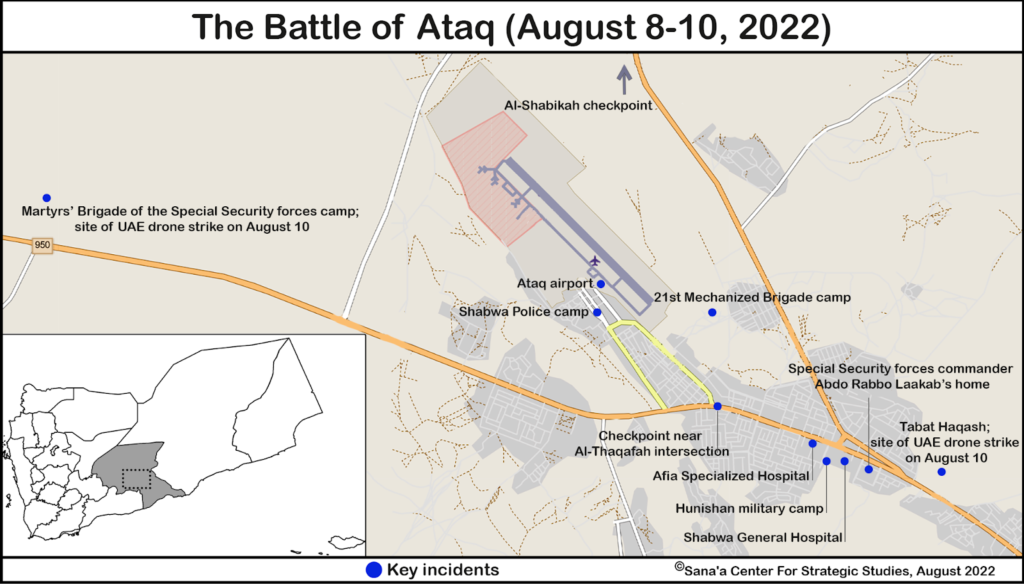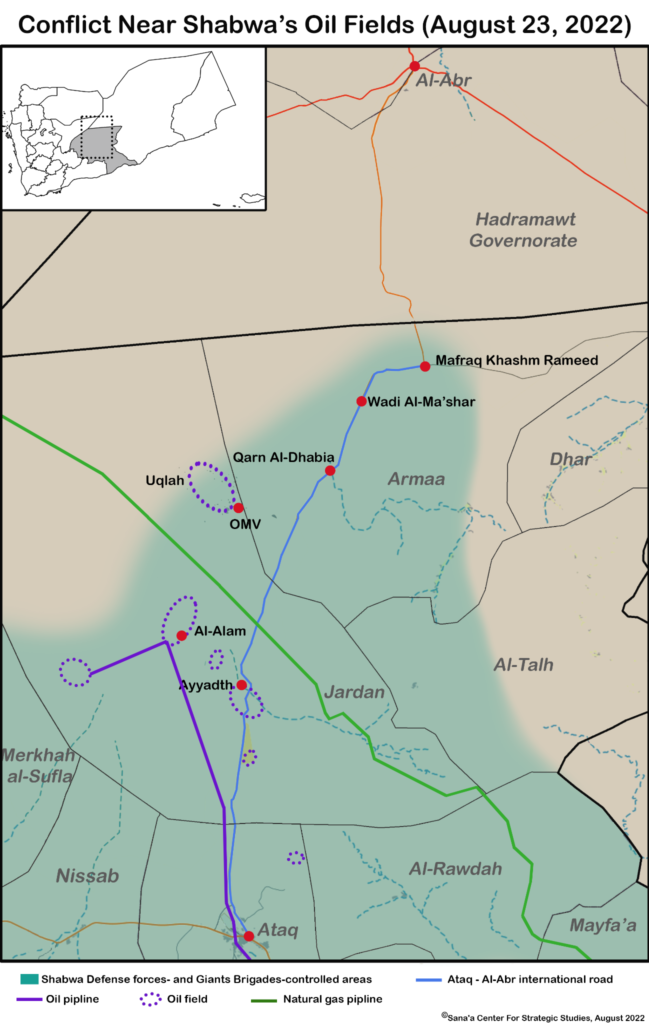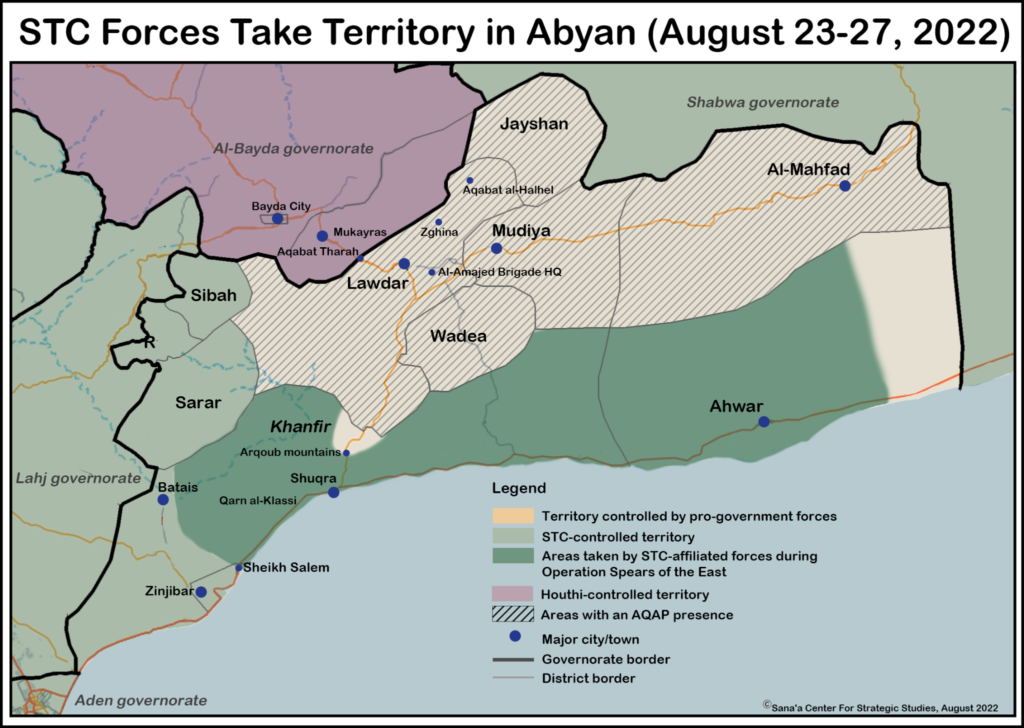The most prominent military developments in August concerned intra-PLC clashes in Shabwa governorate between Islah-aligned and UAE-backed forces. The roots of the Shabwa fighting extend back to late July, when clashes between Islah-aligned government security forces and the STC-aligned Shabwa Defense forces culminated in the July 19 assassination attempt of Islah-aligned commander Abdu Rabu Laakab, who the UAE viewed as the kingpin of opposition to their presence. As a result of the clashes,UAE-backed Governor Awadh Bin al-Wazir al-Awlaki suspended Laakab and commander of the Shabwa Defense forces Second Brigade, Wadji Baoum, with the PLC authorizing Bin al-Wazir to take action to stabilize the situation. On August 6, Awlaki officially replaced Laakab with Colonel Ahmed Nasser al-Ahwal, but the Special Security forces prevented Al-Ahwal from entering the group’s Martyrs’ Camp, west of Ataq, asserting that the governor had overstepped his authority and that such appointments could only be issued by Interior Minister Ibrahim Haidan, who countermanded Bin al-Wazir’s decision.
Large-scale clashes broke out in Ataq on August 8 after the killing of the commander of the Rapid Intervention forces of the pro-Islah Ataq Military Axis, Colonel Ahmed Lashqam Al-Barassi. Lashqam, who was involved in the July clashes, was killed at a new checkpoint near the Al-Thaqafah intersection after clashes broke out between the Giants Brigades and the 30th Infantry Brigade of the Ataq Military Axis. After Lashqam’s death, violent clashes erupted across the city between pro-Islah forces and the Giants Brigades and Shabwa Defense forces. Pro-Islah elements of government forces in Marib mobilized independently and attempted to link up with Special Security forces in Ataq, but were repelled on August 8 and 10. After heavy fighting, Shabwa Defense forces took control of the Hunishan military camp, affiliated with the pro-Islah Ataq Military Axis, on August 8.
Attempting to resolve the crisis, the PLC held an emergency meeting to discuss security developments in Shabwa on August 8, hoping to stabilize the situation with new appointments to the leadership of military, police and security forces. Brigadier General Adel Ali bin Ali Hadi al-Musabi was installed as commander of the Ataq Military Axis and the 30th Armored Brigade, replacing Brigadier General Aziz al-Atiqi; Brigadier General Fouad Mohammed Salem al-Nassi was named Director General of the Shabwa governorate Police, replacing Brigadier General Awad al-Dahboul; and Colonel Mohayyem Mohammed Nasser was appointed Commander of the Special Security forces, replacing Brigadier General Abd Rabbo Laakab. The new appointees were believed to be politically close to their predecessors.
Despite these efforts, heavy clashes continued in Ataq city on August 9-10. Governor Awlaki addressed a statement to several governorate military and security leaders demanding they cease fighting and calling their participation a direct rebellion. The clashes quickly turned in Awlaki’s favor: the 11th and 12th Giants Brigades, supported by Emirati drone strikes, fully engaged in the fighting after positions hosting Emirati forces, including Ataq airport and the governor’s house, came under attack. On August 10, fighters of various Islah-affiliated brigades withdrew from Ataq, and local tribal fighters took their places at major checkpoints. Special Security forces soldiers in Rudum district handed over their camp and its security checkpoints to the 2nd Marine Brigade after locals brokered an agreement, and Southern Resistance forces took over the 2nd Mountain Infantry Brigade camp and all checkpoints in Mayfa’a district. Commanders of pro-Islah groups reportedly fled Shabwa to Marib, and the majority of their troops returned to their homes or fled to other parts of the governorate.

On August 12, pro-Islah forces in the desert outside Ataq shelled positions of Giants Brigade forces at the Murah military camp and in the areas of Naukhan and Al-Shabeeka in northern Ataq. The Giants Brigade responded and fighting between the groups ensued. The same day, heavy clashes erupted in Al-Naqa’ah area, near the oil fields of Ayyadth in Jardan district. Both parties used heavy weapons and aerial drones were reportedly employed to target pro-Islah positions. Giants Brigade forces took advantage of the air support to advance toward the oil fields. By August 15, UAE-backed Shabwa Defense and Giants Brigade forces had reached the International Road that links Shabwa to Al-Abr in Hadramawt. On August 21, after a PLC-ordered ceasefire and redeployment, they also took control of important sites in northern Shabwa, including Mafraq Khashm Rameed on the strategic route between Shabwa and Hadramawt and the oil fields in Armaa and Jardan Districts.

As of late August, fighting in Shabwa appeared to have subsided, although on August 27 security forces loyal to Governor Awlaki claimed to have thwarted an IED attack on the governor’s convoy on the road linking Ataq and the Nisab district. All told, the clashes in Shabwa claimed dozens of lives, although exact figures remain unclear. Earlier in the month, AP reported that 35 people were killed in the fighting. According to Shabwa governorate health office figures, 19 were killed and 82 were injured, including seven civilian deaths and 30 wounded. However, this latter estimate likely undercounts casualties from pro-Islah forces, given that the governorate’s main hospital sites were under the control of UAE-backed groups. Some speculated that fighting would spread into Islah-controlled Wadi Hadramawt, but PLC chief Rashad al-Alimi directed the Giants Brigades and Shabwa Defense forces to remain within the administrative borders of Shabwa and warned that any military or security force that did not abide by the instructions of the governor of Shabwa would be considered a rebel force.
Abyan
In addition to the clashes in Shabwa, moves by STC-aligned forces in neighboring Abyan governorate upended a long-running frontline in favor of the secessionist party. On August 23, days after the fighting in Shabwa had subsided, the STC began deploying forces toward eastern Abyan governorate, which contained Islah-aligned government forces, under the guise of a counter-terrorism campaign. The STC continued with the operation despite explicit orders from PLC head Alimi. Within a day, STC-aligned forces had taken control of the coastal town of Shuqra, which had been the main government stronghold in clashes with the STC in recent years, as well as Ahwar and the road leading to Abyan’s interior. Shuqra was turned over by the Joint Forces of the Abyan Military Axis after local mediation secured the withdrawal of government-aligned forces. In return, pro-government Special Security forces and General Security forces were allowed to return to their bases in Abyan’s capital Zinjibar. On August 27, Governor Abu Bakr Hussein said that STC and pro-government commanders had agreed to confront terrorism together under the leadership of the PLC, the Ministry of Defense, and the Ministry of the Interior. The UAE-backed Giants Brigades appeared to be coordinating the joint manning of checkpoints in Abyan with STC-affiliated forces and the government’s Presidential Protection Brigades.
The new division of territory in Abyan appears to be a partial step toward implementing the 2019 Riyadh Agreement, which sought to deescalate frontlines in Abyan and unify STC and pro-government forces. Following the further spread of STC forces throughout Abyan, the head of the Saudi-led coalition forces, Mohammed Nasser al-Fahadi, led a military delegation to the coalition’s Amajed Brigades in northern Abyan, in what appeared to be a political message to the STC to stay out of the area. Saudi Arabia does not want the STC to take positions in northern Abyan, which would risk bringing Houthi forces into the conflict.
Further to the north in Abyan, fighting continued between Houthi forces and pro-government and Southern Resistance forces, with sporadic clashes reported along the Aqbat Tharah frontlines in Lawdar district earlier in the month. A humanitarian breakthrough was reported on August 18, when local mediation efforts led by Sheikh Yasser Jahlan of Mukayras district succeeded in re-opening the Al-Halhal Road connecting Mukayras district with Lawdar district in Abyan. The Houthis and Southern Resistance forces agreed that the road will be open on Monday, Wednesday, Friday, and Saturday, between 6 a.m. and 6 p.m. However, midway through the STC redeployment in Abyan, Houthi forces blew up a bridge on the strategic Aqabat al-Halhel road, likely fearing that STC-affiliated forces deployed to Abyan could move north toward Mukayras.

Truce Violations
Despite the extension of the truce on August 2 and the ostensible continuation of its armistice component, low-level clashes and troop redeployments were recorded across multiple frontlines. The first significant violation of the truce took place on August 28-29, when the Houthis attacked Wadi al-Dhabab, to the west of Taiz, seeking to cut the last government-controlled road to the city. Houthi leaders also oversaw several large military parades throughout August, with a large buildup of Houthi forces in Hudaydah at the end of the month, prompting a rebuke of Houthi military action from the UN Mission to Support the Hudaydah Agreement on August 30.
Taiz
On August 28, the first major violation of the UN-brokered truce occurred in Al-Dhabab, on the outskirts of Taiz city, when Houthi forces launched an hours-long attack to seize control of the only major road connecting the city to the interim capital Aden. The surprise move followed weeks of military mobilization around Taiz, and was likely driven by concerns that Tareq Saleh’s forces on the west coast could stage an operation in coordination with the pro-Islah Taiz Military Axis to move against Houthi-held areas in Taiz, including the Hawban industrial zone, a major source of tax revenue for the Houthis. At least 10 pro-government soldiers were killed in the clashes, prompting the government to pull out of the UN-backed Military Coordination Committee on August 30. The Houthi action also strengthened the view that their immediate priority if the truce collapses will be the Taiz region, though mobilization in Marib indicates that reopening the fight to take the governorate’s oil fields could also be high on their agenda.
Following direct orders from now-former defense minister Mohammed Ali al-Maqdashi and National Resistance Forces leader Tareq Saleh, the Taiz Military Axis continued a systematic campaign to remove military units billeted in civilian buildings in Taiz city throughout August. Troops from the Taiz Military Axis vacated the Ahmed Faraj School in northwest Taiz City on August 3, and the 5th Presidential Protection Brigade vacated the Faculty of Medicine building at Taiz University in the Sabir al-Mawadim district of Taiz city on August 9, handing it over to the Saudi Development and Reconstruction Program for Yemen. Officials and military forces appropriating civilian buildings and homes has been an issue across many areas of Yemen, and individual governorates have attempted to address the problem with mixed success. Previous initiatives in Taiz had failed to dislodge the troops, but the new campaign has made several arrests to enforce the decision. Saleh’s visit to the city and championing of the removal efforts are likely intended to garner local support for himself and the PLC.
Hudaydah
On August 30, the UN Mission to support the Hudaydah Agreement (UNMHA) issued a statement of “great concern” over “the significant military presence in Hudaydah city” in recent days. The statement represents a rare critical direct rebuke of Houthi actions by the UN mission.
Eritrean harassment of Yemeni fishermen is reported to have increased in recent months, with Houthi authorities claiming 139 Yemeni fishermen are now being held by Eritrean forces. Following a years-long dispute between Yemen and Eritrea over control of the Hanish Islands, an international arbitration court granted Yemen sovereignty in 1998. Eritrea still contests a number of the islands and fishing rights in the Red Sea. Its navy has abducted hundreds of Yemeni fishermen and seized numerous fishing boats since the start of Yemen’s war.
Al-Dhalea
Fighting between Houthi forces and pro-government and Southern Resistance forces continued throughout August in Al-Dhalea, with clashes and shelling reported in the Qaatabah and Murais districts. The Houthis have notably intensified drone strikes on the frontlines in Al-Dhalea. On August 18, a Houthi drone targeted the pro-government 2nd Al-Saiqa Brigade in the area of Hajar, with drone strikes reportedly hitting a number of civilian houses. Aerial drones were reportedly employed again by the Houthis on August 21, targeting pro-government forces in the Qaatabah district and in Bab Ghalq and Habeel al-Abdi. Between August 25 and 27, Houthi forces launched a series of drone attacks on pro-government troops stationed in the Bitar and Al-Jab areas of the Hajar front, and in the Tabat Othman al-Fakher area in northwest Qatabah district. At least one pro-government soldier was killed and several others were wounded.
Landmines
Landmines remain a deadly problem in several areas, with increasing civilian access to frontline areas driving increased casualties. In Al-Bayda governorate, multiple incidents resulting in civilian casualties were reported in Zahir District, with at least one civilian killed in the governorate’s Al-Sawma’ah District on August 1. Mines also remained the largest threat to civilians in Hudaydah governorate, where mines injured several and killed at least five civilians in incidents in Al-Durayhimi, Al-Tuhayta, Al-Hali, and Bayt al-Faqih districts. On August 11, two children were killed after a landmine exploded in a house in Marib city. A child had brought home the landmine, believed to have been dislodged by flooding. A man and another child were badly wounded in the explosion.

 اقرأ المحتوى باللغة العربية
اقرأ المحتوى باللغة العربية